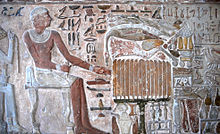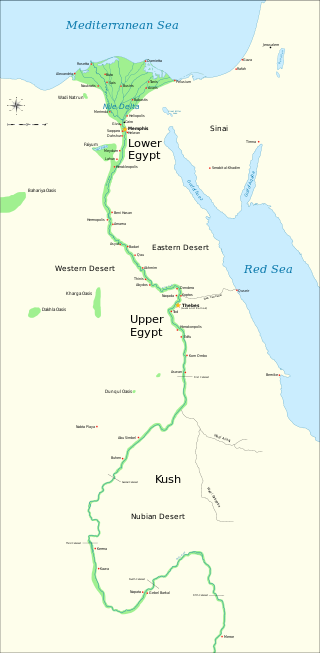
The First Intermediate Period, described as a 'dark period' in ancient Egyptian history, spanned approximately 125 years, c. 2181–2055 BC, after the end of the Old Kingdom. It comprises the Seventh, Eighth, Ninth, Tenth, and part of the Eleventh Dynasties. The concept of a "First Intermediate Period" was coined in 1926 by Egyptologists Georg Steindorff and Henri Frankfort.

The Middle Kingdom of Egypt is the period in the history of ancient Egypt following a period of political division known as the First Intermediate Period. The Middle Kingdom lasted from approximately 2040 to 1782 BC, stretching from the reunification of Egypt under the reign of Mentuhotep II in the Eleventh Dynasty to the end of the Twelfth Dynasty. The kings of the Eleventh Dynasty ruled from Thebes and the kings of the Twelfth Dynasty ruled from el-Lisht.

Deir el-Bahari or Dayr al-Bahri is a complex of mortuary temples and tombs located on the west bank of the Nile, opposite the city of Luxor, Egypt. This is a part of the Theban Necropolis.
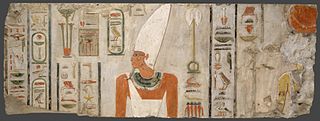
Mentuhotep II, also known under his prenomen Nebhepetre, was an ancient Egyptian pharaoh, the sixth ruler of the Eleventh Dynasty. He is credited with reuniting Egypt, thus ending the turbulent First Intermediate Period and becoming the first pharaoh of the Middle Kingdom. He reigned for 51 years, according to the Turin King List. Mentuhotep II succeeded his father Intef III on the throne and was in turn succeeded by his son Mentuhotep III.

Sehertawy Intef I was a local nomarch at Thebes during the early First Intermediate Period and the first member of the 11th Dynasty to lay claim to a Horus name. Intef reigned from 4 to 16 years c. 2120 BC or c. 2070 BC during which time he probably waged war with his northern neighbor, the Coptite nomarch Tjauti. Intef was buried in a saff tomb at El-Tarif, known today as Saff el-Dawaba.

Wahankh Intef II was the third ruler of the Eleventh Dynasty of Egypt during the First Intermediate Period. He reigned for almost fifty years from 2112 BC to 2063 BC. His capital was located at Thebes. In his time, Egypt was split between several local dynasties. He was buried in a saff tomb at El-Tarif.
Intef III was the third pharaoh of the Eleventh Dynasty of Egypt during the late First Intermediate Period in the 21st century BC, at a time when Egypt was divided in two kingdoms. The son of his predecessor Intef II and father of his successor Mentuhotep II, Intef III reigned for 8 years over Upper Egypt and extended his domain North against the 10th Dynasty state, perhaps as far north as the 17th nome. He undertook some building activity on Elephantine. Intef III is buried in a large saff tomb at El-Tarif known as Saff el-Barqa.

Sankhkare Mentuhotep III of the Eleventh Dynasty was Pharaoh of Egypt during the Middle Kingdom. He was assigned a reign of 12 years in the Turin Canon.

The ancient Egyptian noble Intefiqer(ỉnỉ-ỉt.f ỉqr) was overseer of the city and Vizier under Amenemhet I and Senusret I during the early 12th Dynasty. He is known from several rock inscriptions in Lower Nubia, showing that he was part of a military mission into this region. He appears in an inscription found at the Red Sea coast and in the so-called Reisner Papyrus. Two rock inscriptions in Lower Nubia mention him. They seem to indicate that he was involved in a military campaign into this region. The inscriptions are not dated, but other inscriptions in the region seem to indicate a military campaign in year 29 of Amenemhet I, which corresponds to the 9th year of Senusret I. Intefiqer is also known from a stela found at Wadi el-Hudi, dated to year 20. It reports the bringing of amethyst.

Theban Tomb TT2 is located in Deir el-Medina, part of the Theban Necropolis, on the west bank of the Nile, opposite to Luxor. It is the burial place of the ancient Egyptian official, Khabekhnet, and his family. Khabekhnet was Servant in the Place of Truth, during the reign of Ramesses II.

The Theban Tomb TT57 is located in Sheikh Abd el-Qurna. It forms part of the Theban Necropolis, situated on the west bank of the Nile opposite Luxor. The tomb is the burial place of the ancient Egyptian official Khaemhat, who was royal scribe and overseer of double granary, during the reign Amenhotep III. The relief decoration of the tomb is regarded as the best of New Kingdom art.

The Theban Tomb TT319 is located in Deir el-Bahari, part of the Theban Necropolis, on the west bank of the Nile, opposite to Luxor. The tomb belongs to the king's wife Neferu II, wife of the ancient Egyptian king Mentuhotep II. Neferu was the daughter of Queen Iah and Intef III.
The Theban Tomb of Meru TT240 is located in El-Assasif, Theban Necropolis. It overlooks the mortuary temple of the 11th Dynasty Pharaoh Mentuhotep II.
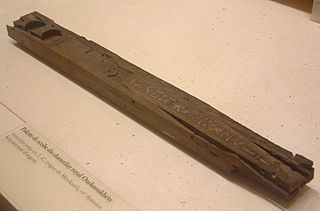
Merikare was an ancient Egyptian pharaoh of the 10th Dynasty who lived toward the end of the First Intermediate Period.
Purportedly inspired by the teaching of his father, he embarked on a semi-peaceful coexistence policy with his southern rivals of the 11th Dynasty, focusing on improving the prosperity of his realm centered on Herakleopolis instead of waging an open war with Thebes. His policy was not rewarded, and shortly after his death his kingdom was conquered by the Theban Mentuhotep II, marking the beginning of the Middle Kingdom. The existence of his pyramid has historically been ascertained, although it has not yet been discovered.

Dagi was an ancient Egyptian vizier during the reign of pharaoh Mentuhotep II of the Eleventh Dynasty.

Kheti was an ancient Egyptian treasurer of the 11th Dynasty, under king Mentuhotep II. Kheti appears in several sources and was one of the most influential figures at the royal court of the king. He is depicted in two rock reliefs at Shatt er-Rigal where he is standing in front of the king. Once the king wears the Sed festival dress. It can be assumed that Kheti was involved in arranging the festival for the king. His name and title appear in the funerary temple of the king in Deir el-Bahari and he had a tomb near the funerary temple of his king. The tomb (TT311) was found heavily destroyed but there are still many remains of reliefs showing that it was once decorated. The burial chamber was better preserved and was also decorated. His successor was Meketre.
Intef (Antef) was an Ancient Egyptian general of the 11th Dynasty, around 2000 BC, under king Mentuhotep II. His main title was overseer of troops often translated as general. Other titles include royal sealer and sole friend.

Sekhemre Sementawy Djehuti was possibly the second king of the Theban 16th Dynasty reigning over parts of Upper Egypt during the Second Intermediate Period. Alternatively, he may be a king of the late 13th Dynasty or the fourth king of the 17th Dynasty. Djehuty is credited with a reign of 3 years in the first entry of the 11th column of the Turin canon. According to Egyptologists Kim Ryholt and Darrell Baker, he was succeeded by Sobekhotep VIII.
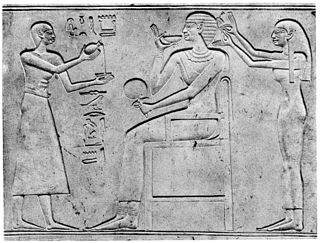
Kawit was an ancient Egyptian queen consort, a lower ranking wife of Pharaoh Mentuhotep II of the 11th Dynasty. Her tomb (DBXI.9) and small decorated chapel were found in her husband's Deir el-Bahari temple complex, behind the main building, along with the tombs of five other ladies, Ashayet, Henhenet, Kemsit, Sadeh and Mayet. She and three other women of the six bore queenly titles, and most of them were priestesses of Hathor, so it is possible that they were buried there as part of the goddess's cult, but it is also possible that they were the daughters of nobles the king wanted to keep an eye upon.

"Khonsuemheb and the ghost", often known simply as A ghost story, is an ancient Egyptian ghost story dating back to the Ramesside period. Its protagonist is a priest named Khonsuemheb and the story revolves around his encounter with a restless ghost.
